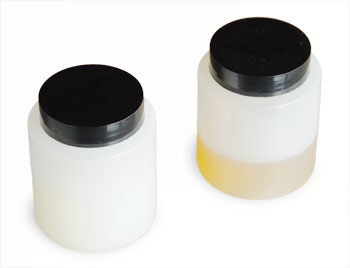Donadoni
Epoxy glue 150 g.

This EPOXY is satisfactory for the gluing of WOOD, METALS, HORN, CERAMICS, STONE, CONCRETE, RUBBER, FOAM and a large range of PLASTIC MATERIALS.
It provides high bond strength and good mechanical properties. It is satisfactory in wet environments and resistant to petrol and oil.
The glue comprises two components: The RESIN (white in color) and the CATALYST (honey color). The two components have a long shelf life if kept tightly sealed and in a cool environment. Care must be taken to not interchange lids or cross-contaminate containers with utensils.
MIXING INSTRUCTIONS: The components must be mixed in the ratio 1 to 2 by weight..Combine 1 PART CATALYST (honey color) with 2 PART RESIN (white) in a clean container and mix throughly. Failure to mix throughly will cause failures.
WORKING TIME: After mixing you will have approximately two hours at room temperature (18-20°C) before the glue becomes too thick to work with. This time will decrease in warmer conditions and increase in colder conditions.
SURFACE PREPARATION: The surfaces to be glued must be clean free from dust, grease or oil and suitably roughened by sanding or similar action. Surface contamination is often caused by transfer of oil from hands. Avoid handling and if contaminated clean with Acetone or similar solvent.
APPLICATION: The glue should be applied to both surfaces to be bonded in a thin even layer. The most common way to apply is by using a spatula or brush.
CLAMPING OF COMPONENTS: After the components have been assembled they should be clamped with sufficient pressure to squeeze out excess glue and to ensure the glue lines are thin and uniform. Care needs to be exercised to avoid excessive clamping pressure as this can cause insufficient glue in the joint and result in failures.
CURING TIMES: The glue will cure at room temperatures but best results are achieved by curing at elevated temperatures as this produces increased bond strength and physical properties as well as decreased cure times: The cure times are: 7 days at 20° C 6 hours at 40° C 2 hours at 70° C 10 minutes at 100° C.
For bows and other wooden materials it is not recommended to exceed 70°C. Most bowyers work in the range of 40-70°C and the lower temperature is prudent if you are not sure of the results.
PREPARATION FOR GLUING: Before beginning the gluing operation it is a good idea to assemble all the components and fully clamp to check that the operation will be smooth and trouble free, as this avoids many problems later. Provision should be made to protect jigs, fixtures, forms and clamps from excess glue. This can be achieved by the application of plastic tape to susceptible surfaces or by using plastic film laid under and over the job.
Sometimes it is possible to use oil or wax on surfaces for protection but this risks cross-contamination and should be used with caution.
ACHIEVING ELEVATED CURE TEMPERATURES: During the summer months suitable temperatures can be archived by enclosing the components in a closed car or in a metal box in the sun. During winter some sort of oven will be needed. This can be arranged by making a suitable sized enclosure from wood and lining with foam insulating board then placing a 2 or 3 incandescent light bulbs inside with the components to provide the warmth. A dimmer or thermostat can be used to control the temperature. Wiring should be checked by a competent person and care needs to be exercised to avoid possible overheating or fires.
UNCLAMPING AFTER GLUING: Components should be allowed to completely cool before removing clamping pressure as otherwise distortion may occur. It is recommended that 2 days be allowed after gluing before using the bows.


Follow us